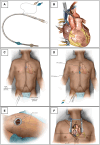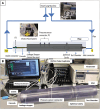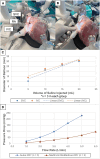Innovative balloon-inflatable venous cannula for enhanced cardiopulmonary bypass in minimally invasive cardiac surgery
- PMID: 39906968
- PMCID: PMC11829808
- DOI: 10.1093/icvts/ivaf017
Innovative balloon-inflatable venous cannula for enhanced cardiopulmonary bypass in minimally invasive cardiac surgery
Abstract
Objectives: Minimally invasive cardiac surgery (MICS) struggles with effective caval isolation and cannulation for cardiopulmonary bypass (CPB). We aimed to develop a novel MICS venous cannula, eliminating external manipulations. The goal of this study is to thoroughly evaluate both the safety and the efficacy of a newly developed venous cannula.
Methods: The study presents the Aulus venous cannula for MICS, designed with internal balloons to block caval blood flow. Preclinical bench tests with a cardiac biosimulator and large animal studies per ISO10993-2016, evaluated performance and safety.
Results: The heparin-coated Aulus cannula had a post-sterilization comparable density of ∼0.200 μg/cm2. In ex vivo tests, using porcine heart models, the cannula enabled full caval occlusion, with endoscopic views confirming precise positioning. The pressure drop remained below the haemolytic threshold of 100 mmHg, indicated lower values compared to BioMedicus. A non-Good Laboratory Practice (GLP) large animal study included eight ovine models, divided into short- and long-term follow-up groups. Clinical pathology values were consistent CPB procedures, and histopathology indicated favourable tolerance despite short-term vessel injuries and long-term stenosis with fibrosis.
Conclusions: The Aulus cannula showed effective anticoagulant activity, strong integrity, and good tolerance in vitro and in vivo, highlighting its clinical potential.
Keywords: aulus; cannula; cardiopulmonary bypass; minimally invasive cardiac surgery; open heart surgery.
© The Author(s) 2025. Published by Oxford University Press on behalf of the European Association for Cardio-Thoracic Surgery.
Conflict of interest statement
The author declares no conflict of interest, except for research funding.
Figures






Similar articles
-
Vacuum-assisted venous drainage in extrathoracic cardiopulmonary bypass management during minimally invasive cardiac surgery.Perfusion. 2006 Nov;21(6):361-5. doi: 10.1177/0267659106071324. Perfusion. 2006. PMID: 17312860 Clinical Trial.
-
Single-Center Experience With a Self-Expandable Venous Cannula During Minimally Invasive Cardiac Surgery.Innovations (Phila). 2022 Nov-Dec;17(6):491-498. doi: 10.1177/15569845221131534. Epub 2022 Oct 30. Innovations (Phila). 2022. PMID: 36314445
-
Venous cannula performance assessment in a realistic caval tree model.Interact Cardiovasc Thorac Surg. 2015 Feb;20(2):194-9. doi: 10.1093/icvts/ivu318. Epub 2014 Nov 2. Interact Cardiovasc Thorac Surg. 2015. PMID: 25368132
-
Negative fluid displacement: an alternative method to assess patency of arterial line cannulation.Perfusion. 2003 Mar;18(1):67-70. doi: 10.1191/0267659103pf636oa. Perfusion. 2003. PMID: 12705653 Review.
-
Single, percutaneous, femoral venous cannulation for cardiopulmonary bypass.Perfusion. 2007 May;22(3):211-5. doi: 10.1177/0267659107083021. Perfusion. 2007. PMID: 18018402 Review.
References
-
- Lamelas J, Williams RF, Mawad M, LaPietra A. Complications associated with femoral cannulation during minimally invasive cardiac surgery. Ann Thorac Surg 2017;103:1927–32. - PubMed
-
- Sazzad F, Kuzemczak M, Kofidis T. A novel minimally invasive technique of temporary caval occlusion for right heart surgery. Ann Thorac Surg 2020;109:e309–11. - PubMed
-
- Morales D, Williams E, John R. Is resternotomy in cardiac surgery still a problem? Interact CardioVasc Thorac Surg 2010;11:277–86. - PubMed
Grants and funding
LinkOut - more resources
Full Text Sources

